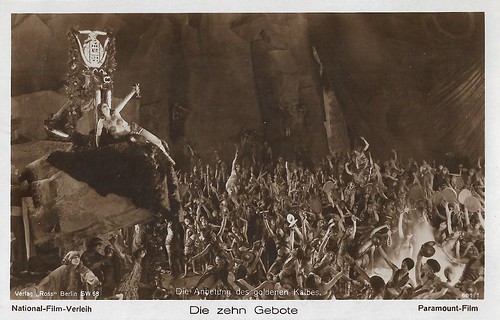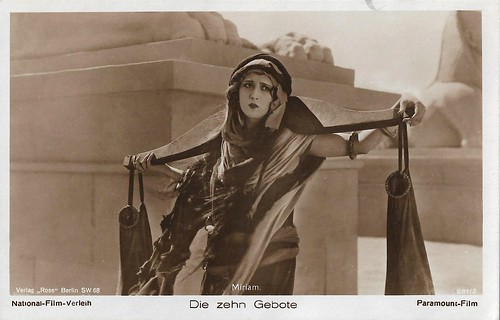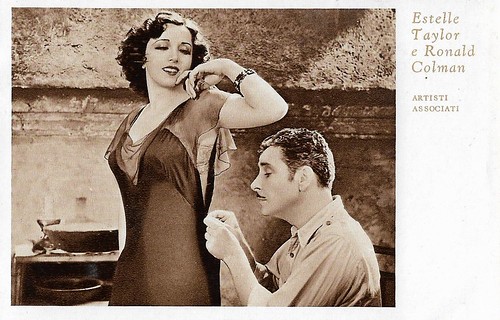
British postcard in the Picturegoer Series, London, no. 219.

British postcard in the Picturegoer Series, London, no. 219a. Photo: Radio Pictures.

French postcard by Cinémagazine-Edition, Paris, no. 288.
A comedy vamp
Ida Estelle Taylor was born in 1894, in Wilmington, Delaware. Her father was Harry D. Taylor and her mother was Ida LaBertha "Bertha" Barrett. The Taylors had another daughter, Helen, who also became an actress.
In 1911, Estelle married bank cashier Kenneth M. Peacock. The couple remained together for five years until Taylor decided to become an actress. In 1918, Taylor moved to New York City to study acting at the Sargent Dramatic School.
She made her stage debut as a 'comedy vamp' in the play 'Come-On, Charlie', by George V. Hobart. Taylor began looking for work in films. With the help of J. Gordon Edwards, she got a small role in the film A Broadway Saint (Harry O. Hoyt, 1919) starring Montagu Love.
She was hired by the Vitagraph Company for a role with Corinne Griffith in The Tower of Jewels (Tom Terriss, 1920), and also played William Farnum's leading lady in The Adventurer (J. Gordon Edwards, 1920) for the Fox Film Corporation.
She achieved her first notable success with the crime drama While New York Sleeps (Charles Brabin, 1920) with Marc McDermott. She was a contract player of Fox and William Fox sent her to Fox Film's Hollywood studios. There she played Mercedes opposite John Gilbert as Edmond Dantès in Monte Cristo (Emmett J. Flynn, 1922), based on the novel by Alexandre Dumas.

German postcard by Ross Verlag, no. 681/1. Photo: Paramount-Film / National-Verleih. Estelle Taylor as the woman who embraces the Golden Calf, in The Ten Commandments (Cecil B. DeMille, 1923). Caption: The Adoration of the Golden Calf.

German postcard by Ross Verlag, no. 681/2. Photo: Paramount-Film / National-Verleih. Estelle Taylor as Miriam, sister of Moses in The Ten Commandments (Cecil B. DeMille, 1923). Caption: Miriam.

Reproduction of film still for Don Juan (Alan Crossland, 1926). John Barrymore as Don Juan fighting Count Giano Donati (Montague Love), while Cesare Borgia (Warner Oland) and Lucrezia Borgia (Estelle Taylor) look on. Set design by Ben Carré.

Italian postcard by Cinema-Illustrazione, series 2, no. 24. Photo: United Artists. Estelle Taylor and Ronald Colman in The Unholy Garden (George Fitzmaurice, 1931).
Miriam, the sister of Moses
Estelle Taylor played one of her most memorable roles as Miriam, the sister of Moses (Theodore Roberts), in the biblical prologue of The Ten Commandments (Cecil B. DeMille, 1923), one of the most successful films of the silent era. Her performance in the DeMille film was considered a great acting achievement.
Taylor signed a contract with Paramount Pictures on the strength of her performance as Miriam. She was again praised for her portrayal of Mary, Queen of Scots in Dorothy Vernon of Haddon Hall (Marshall Neilan, 1924) starring Mary Pickford. She became even more famous in 1925 when she married heavyweight champion boxer Jack Dempsey.
The following year, she played Lucrezia Borgia in Don Juan (Alan Crosland, 1926) starring John Barrymore. This was the first feature-length film to use the Vitaphone sound-on-disc sound system with a synchronised musical score and sound effects, though it has no spoken dialogue. Notable sound films in which she appeared include Street Scene (King Vidor, 1931), with Sylvia Sidney, the Academy Award for Best Picture-winning Cimarron (Wesley Ruggles, 1931), with Richard Dix and Irene Dunne, and Call Her Savage (John Francis Dillon, 1932), with Clara Bow.
Although she had made a successful transition to sound films, Taylor retired from film acting in 1932 and decided to focus entirely on her singing career, receiving a salary of $1,000 a week. She performed in Vaudeville, on the stage in musicals, and in nightclubs. At one point, she even gave a concert at New York's Carnegie Hall.
Taylor returned to films with a small part in the Jean Renoir drama The Southerner (1945). It was her last film. Estelle Taylor was also active in animal welfare before her death from cancer in 1958. She was married three times. After her marriage to Jack Dempsey ended in divorce in 1931, she was married to theatrical producer Paul Small (1943-1945).

Austrian postcard by Iris Verlag, no. 590. Photo: Irving Chidnoff, N.Y.

German postcard by Ross Verlag, no. 3835/1, 1928-1929. Photo: Fox.

Italian postcard by G.B. Falci, Milano, no. 402. Photo: Fox Films Corp. S.A.I.

Spanish postcard by Dümmatzen, no. 68. Photo: United Artists.
Sources: Wikipedia and IMDb.
No comments:
Post a Comment